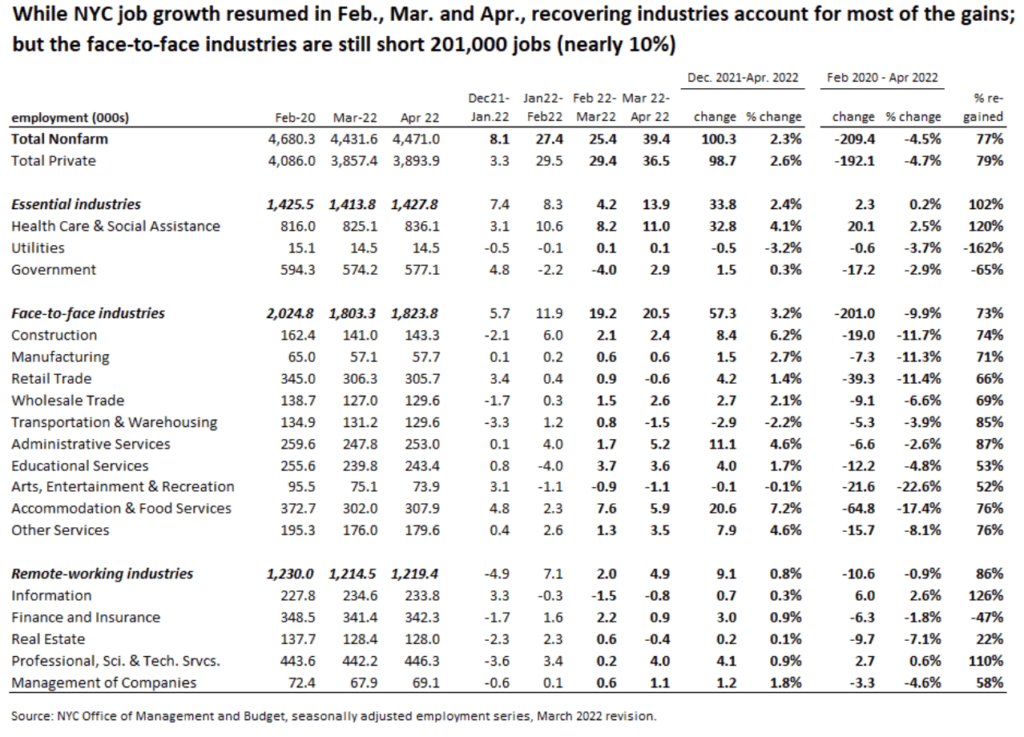New York City has gained back 100,000 jobs during the first four months of this year but employment in face-to-face industries is still nearly 10 percent below pre-pandemic levels.
COVID-19 Economic Update is a bi-weekly column prepared by economist James Parrott of the Center for New York City Affairs (CNYCA) at The New School, whose research is supported by the Consortium for Worker Education and the 21st Century ILGWU Heritage Fund. Read past installments here.
New York City’s employment picture continues to creep back from pandemic declines but still has far to go to recover its pre-pandemic employment level. The city added 39,400 jobs in April on a seasonally adjusted basis, the largest monthly gain since July of 2021. The previously reported March gain of 31,400 jobs was revised downward by 6,000 jobs to 25,400.
Most of the April job rebound occurred in the face-to-face industries, led by full-service restaurants (+ 7,200 jobs, not seasonally adjusted since seasonally adjusted data are not available for detailed industries). Other face-to-face industries adding jobs in April included hotels, other services, construction, wholesale trade, and private colleges and universities. Employment in all of these industries is still below the pre-pandemic February 2020 level, and the face-to-face industries as a group are still 201,000 jobs (9.9 percent) short of the February 2020 level. The face-to-face industries have gained back 73 percent of the jobs lost during the first two months of the pandemic.
The accompanying table shows that total nonfarm employment increased by 100,000 jobs (or 2.3 percent) from December of last year through April of this year on a seasonally adjusted basis. Five industries accounted for four-fifths of this job gain, led by accommodation and food services which added nearly 21,000 jobs (a 7.2 percent gain), followed by construction with a 6.2 percent gain, and administrative services (including employment and building services), and other services (including personal care and laundry services), both with 4.6 percent employment increases over the first four months of 2022. The fifth industry, the very large health care and social assistance combined sector, added nearly 33,000 jobs, or 4.1 percent. Most of the gain in this sector occurred in home health care services.
A sixth industry, computer systems design and related services, increased employment by 5.0 percent (4,000 jobs on a not seasonally adjusted basis) between December 2021 and April 2022. The broader professional and technical services sector of which computer systems is a component showed a net gain of only 4,100 jobs over this period. Generally, the remote-working industries increased employment by only 0.8 percent over the first four months of this year. Finance and insurance employment rose only 0.9 percent and information gained only 0.3 percent.
On a seasonally adjusted employment basis, the arts, entertainment and recreation industry did not register any job growth over the first four months of this year, most likely due to the continuing effects of the coronavirus in dampening theater-going.

New York City’s seasonally adjusted unemployment rate held steady at 6.4 percent in April, with 254,000 city residents officially counted as unemployed. For the first quarter of this year, 37 percent of the city’s unemployed had been without work for more than six months, with nearly two-thirds of those unemployed for more than a year. The percent of the unemployed who were long-term unemployed (more than six months) varied considerably by race and ethnicity, with nearly half of unemployed Blacks long-term unemployed, compared to 34 percent for Latinx workers, 32 percent for white workers, and 29 percent for Asian and other workers.
During the first quarter of 2022, the employment-to-population ratio (EPOP) was only 50 percent for Blacks, 52 percent for Asian and other workers, 54 percent for Latinx workers, and 61 percent for white workers.
# # #
